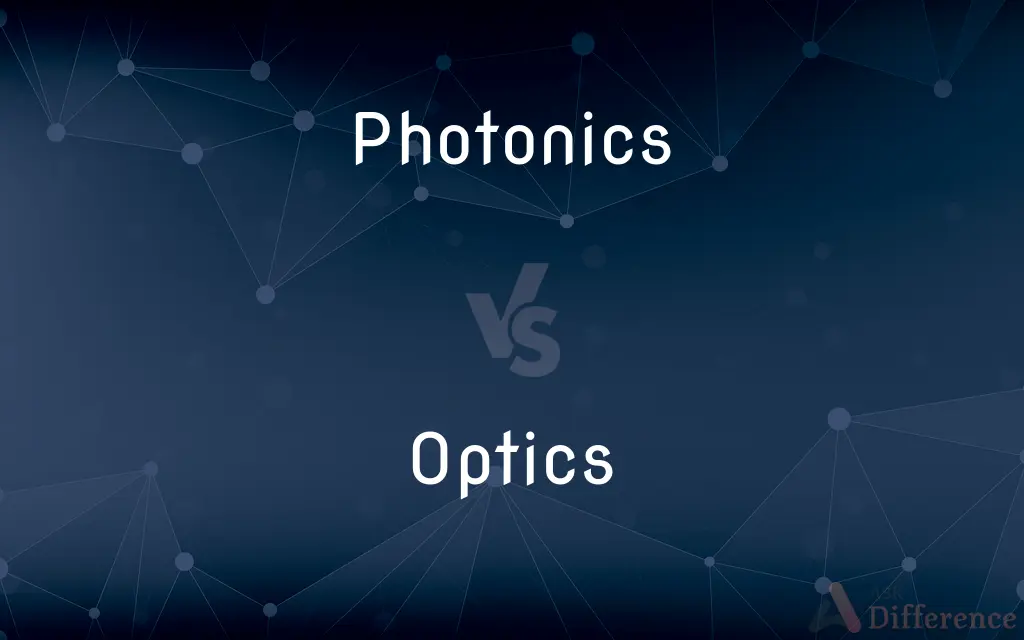Photonics vs. Optics — What's the Difference?
By Fiza Rafique & Maham Liaqat — Updated on April 1, 2024
Photonics involves manipulating photons for applications like communication, while optics focuses on understanding and managing light's behavior through various media.

Difference Between Photonics and Optics
Table of Contents
ADVERTISEMENT
Key Differences
Photonics is a branch of technology concerned with the generation, control, and detection of photons, particularly in the visible and near-infrared spectrum. It encompasses applications ranging from fiber-optic communication to laser manufacturing. On the other hand, optics is the scientific study of light's properties and behavior, including its interactions with matter. It is foundational in understanding how light can be manipulated and utilized in various applications, from eyeglasses to telescopes.
While photonics often deals with the practical application of light, including the development of technologies like LEDs and photovoltaics, optics tends to focus more on the theoretical aspects of light propagation and manipulation. Whereas photonics might be involved in creating a new laser cutting tool, optics would be more concerned with calculating the light path and understanding the laser's interaction with materials.
Photonics technologies are critical in modern telecommunications, relying on light for data transmission over fiber optic cables. This application demonstrates the importance of photonics in achieving high-speed, long-distance communication. Conversely, traditional optics plays a crucial role in designing the lenses and fiber optics themselves, focusing on light transmission efficiency and minimizing loss.
In medical fields, photonics is pivotal in developing diagnostic and therapeutic tools, such as in laser surgery and optical coherence tomography. These technologies rely on precise control over light to achieve desired outcomes. Meanwhile, optics contributes to understanding how light interacts with biological tissues, enabling the development of these photonics-based tools.
Photonics is also integral to quantum computing and information processing, where it utilizes the quantum properties of photons for computation and secure communication. In contrast, optics provides the necessary theoretical framework and practical techniques for manipulating and measuring light at this fundamental level.
ADVERTISEMENT
Comparison Chart
Definition
Technology involving the use and manipulation of photons.
Science of light, including its behavior and properties.
Focus
Practical applications like communication and sensing.
Theoretical and practical aspects of light manipulation.
Applications
Telecommunications, laser manufacturing, medical devices.
Lens design, optical instruments, telescopes.
Tools & Devices
Lasers, LEDs, photovoltaic cells, optical fibers.
Lenses, mirrors, prisms, telescopes, microscopes.
Key Principles
Quantum mechanics, photon generation, modulation.
Wave-particle duality, refraction, reflection, diffraction.
Compare with Definitions
Photonics
Involves the design and application of optical systems using photon manipulation.
Photonics has led to advancements in laser eye surgery.
Optics
Study of light's behavior and its interaction with different materials.
Optics explains how rainbows form through light refraction.
Photonics
Technology focusing on generating and harnessing light particles, photons, for various applications.
Fiber optics revolutionized telecommunications through photonics.
Optics
Fundamental in designing instruments like eyeglasses and cameras.
Precise optics ensure clear vision correction in eyeglasses.
Photonics
Critical in developing energy solutions like photovoltaic cells for solar power.
Solar panels convert sunlight into electricity using photonics principles.
Optics
Explores phenomena such as reflection, refraction, and diffraction.
Optics principles are applied in creating holograms.
Photonics
Basis for quantum computing and secure communication technologies.
Photon-based quantum computers promise unprecedented computational power.
Optics
Enables the development of microscopes for scientific research.
Microscopes rely on optics to magnify small objects for study.
Photonics
Plays a significant role in sensors and imaging devices.
Digital cameras utilize photonics technology for improved image capture.
Optics
Critical in astronomical observations through telescopes.
Telescopes use optics to bring distant galaxies into view.
Photonics
Photonics is the physical science and application of light (photon) generation, detection, and manipulation through emission, transmission, modulation, signal processing, switching, amplification, and sensing. Though covering all light's technical applications over the whole spectrum, most photonic applications are in the range of visible and near-infrared light.
Optics
Optics is the branch of physics that studies the behaviour and properties of light, including its interactions with matter and the construction of instruments that use or detect it. Optics usually describes the behaviour of visible, ultraviolet, and infrared light.
Photonics
The study or application of electromagnetic energy whose basic unit is the photon, using technology such as optics, lasers and other light sources, fiber optics, electrical engineering, and materials science in numerous applications including communications, electrical engineering, materials science, and information storage and processing.
Optics
(used with a sing. verb) The branch of physics that deals with light and vision, chiefly the generation, propagation, and detection of electromagnetic radiation having wavelengths greater than x-rays and shorter than microwaves.
Photonics
(sciences) The science and technology of generating and controlling photons, particularly in the visible and near infrared light spectrum.
Optics
(used with a pl. verb) Informal The way a situation or action appears to the general public
Voters were put off by the optics of the candidate's financial dealings.
Optics
(physics) The physics of light and vision.
Optics
The light-related aspects of a device.
The optics of this telescope are particularly good.
Optics
(figuratively) Perception, image, public relations, especially in politics.
Optics
That branch of physical science which treats of the nature and properties of light, the laws of its modification by opaque and transparent bodies, and the phenomena of vision.
Optics
The branch of physics that studies the physical properties of light
Common Curiosities
How does photonics contribute to quantum computing?
Photonics is key in developing quantum computing technologies by using photons for processing and transmitting quantum information.
Can photonics improve energy efficiency?
Yes, through technologies like LED lighting and photovoltaic cells, photonics contributes to more efficient energy use and generation.
How do telescopes use optics?
Telescopes use lenses or mirrors to collect and focus light from distant objects, making them appear closer and more detailed.
What role does photonics play in healthcare?
It offers diagnostic and therapeutic technologies, such as in non-invasive surgeries and imaging techniques like optical coherence tomography.
What does optics study?
Optics studies the properties and behavior of light, including its interactions with matter and the construction of instruments that use or detect it.
How do optics improve vision?
By designing lenses that correct refractive errors, optics enhances vision clarity through eyeglasses or contact lenses.
What is the principle of optics in photography?
Optics principles are applied in camera lenses to focus light and create sharp images of objects at various distances.
How is photonics used in telecommunications?
Photonics is used in fiber-optic cables to transmit data at high speeds over long distances by converting electronic signals into light pulses.
What is photonics?
Photonics is the technology and science of generating, controlling, and detecting photons, especially in the visible and near-infrared spectrum.
What advancements has optics made in microscopy?
Optics has enabled the development of high-resolution microscopes that can magnify tiny structures, advancing scientific research in various fields.
Share Your Discovery

Previous Comparison
Lime vs. Calcium
Next Comparison
Exanthem vs. EnanthemAuthor Spotlight
Written by
Fiza RafiqueFiza Rafique is a skilled content writer at AskDifference.com, where she meticulously refines and enhances written pieces. Drawing from her vast editorial expertise, Fiza ensures clarity, accuracy, and precision in every article. Passionate about language, she continually seeks to elevate the quality of content for readers worldwide.
Co-written by
Maham Liaqat













































